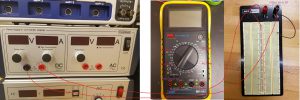Ohm’s Law
Purpose: To verify Ohm’s Law
Objectives
- To learn how to measure current through and voltage across a resistor.
- To learn how to record experimental data using spreadsheet
- To learn how to plot, and analyze data using a spreadsheet.
Equipment:
- Two multimeters, breadboard, and a 2,000-Ohm Resistor
- Power supply
Theory
The relationship between the current through and the voltage across a resistor is given by Ohm’s Law
Here, the current I is given in amp, the voltage V is in Volt, and the resistance R is in Ω
Preliminary Setup.

Create a complete circuit using the power supply, one of the multimeters and the 2000-Ohm resistor on the breadboard.
Warning! Make sure the multimeter is switched to current-measuring mode. The knob must point to the amps, or else you can blow the fuse.
Warning! Make sure the voltage know of the power supply is turned down to zero before you turn it on.
Connect a voltmeter across the resistor.
Activity 1.
Measure the current through and voltage across the resistor.
Adjust the power supply so that the current through the resistor is 1 mA. Measure the voltage in Volts
Activity 2.
- Open Microsoft Excel Spreadsheet and type in your data. Make sure the current is recorded in A and not mA.
- Get the spreadsheet to calculate the resistance for you.
- Using excel, plot a graph Voltage versus Current I.
Question: Do you get a straight line?
